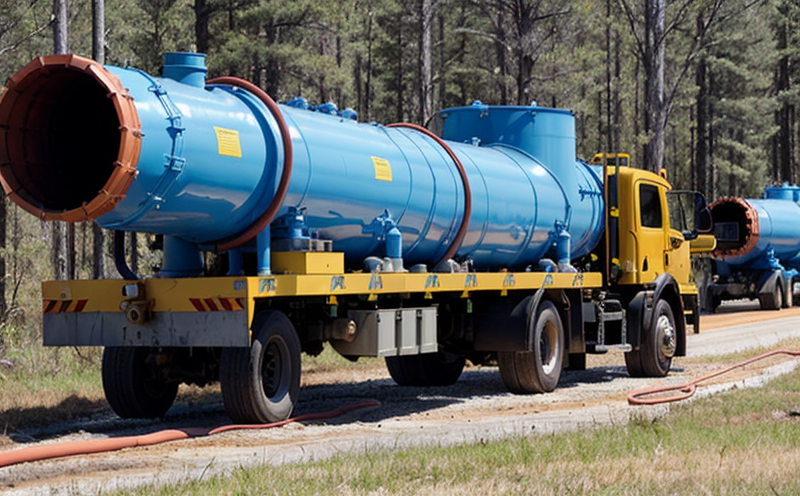EN 14161 Pipeline Transportation System Testing for Gas Systems
The EN 14161 standard specifies requirements and methods for testing pipeline transportation systems used in the distribution of natural gas. This critical procedure ensures that pipelines are safe, reliable, and compliant with international standards, thereby protecting public safety and environmental integrity.
EN 14161 applies to all types of gas transport networks, including those serving residential, commercial, industrial, and institutional customers. The standard is designed for the testing, inspection, and certification of pipeline transportation systems before commissioning or after major modifications. It mandates rigorous tests to verify that these systems meet stringent safety standards.
Compliance with EN 14161 is essential for operators of gas distribution networks to ensure regulatory compliance and operational reliability. The standard covers a wide range of testing methods, including non-destructive testing (NDT), pressure testing, leakage detection, and integrity assessment. These tests are conducted using various specialized equipment such as ultrasonic probes, magnetic particle detectors, and helium leak testers.
The primary goal of EN 14161 is to establish a harmonized approach to pipeline integrity management across Europe. This standard ensures consistency in testing methodologies, which is crucial for the safe operation of gas networks. By adhering to this standard, operators can demonstrate their commitment to safety and quality assurance.
EN 14161 also emphasizes the importance of continuous monitoring and maintenance of pipeline systems. Regular inspections and tests help identify potential issues early, allowing for timely repairs and preventing accidents. The standard provides guidelines on how often testing should be conducted based on factors like age, material type, and geographical location.
For operators of gas distribution networks, compliance with EN 14161 is not just a regulatory requirement but also a strategic decision. It helps build trust among stakeholders by demonstrating the commitment to safety and quality. By adhering to this standard, companies can reduce the risk of accidents, improve operational efficiency, and enhance their reputation.
EN 14161 covers various aspects of pipeline transportation system testing, including:
- Visual inspection
- Internal and external corrosion assessment
- Leak detection using helium gas
- Pressure testing to ensure structural integrity
- Magnetic particle examination for surface flaws
- Ultrasonic testing for internal wall thickness measurement
The standard also provides detailed procedures for conducting these tests, ensuring that they are carried out consistently and accurately. This consistency is vital for maintaining the integrity of gas distribution networks.
Applied Standards
The primary applied standard for this service is EN 14161: Pipeline Transportation System Testing for Gas Systems. This standard is widely recognized and used across Europe to ensure the safety and reliability of gas distribution networks.
In addition to EN 14161, other relevant standards include:
- ISO 9723: Non-destructive testing - Ultrasonic methods
- ASTM E709: Standard practice for leak testing of pressure systems
- IEC 61526-4: Measurement of gas flow in pipelines using ultrasonic meters
These standards provide additional guidance on specific aspects of pipeline transportation system testing, ensuring a comprehensive approach to safety and quality.
Industry Applications
| Pipeline Type | Description | Testing Methodologies |
|---|---|---|
| Mainline Pipelines | Large-diameter pipelines that transport gas over long distances. | Pressure testing, ultrasonic testing, and magnetic particle examination. |
| Service Lines | Pipelines connecting the mainline to individual properties or buildings. | Helium leak detection and visual inspection. |
| Trunklines | High-capacity pipelines that distribute gas from a central point to various regions. | Pressure testing, internal corrosion assessment, and magnetic particle examination. |
Eurolab Advantages
At Eurolab, we pride ourselves on offering comprehensive EN 14161 pipeline transportation system testing services that are tailored to meet the specific needs of our clients. Our team of experts ensures that all tests are conducted in accordance with the latest standards and guidelines.
We utilize state-of-the-art equipment and technology to provide accurate and reliable test results. Our experienced technicians have extensive knowledge and experience in pipeline testing, allowing us to deliver high-quality services that exceed industry expectations.
Our commitment to quality is reflected in the detailed reports we produce after each test. These reports provide comprehensive insights into the condition of the pipelines, helping operators make informed decisions about maintenance and repairs. By partnering with Eurolab, clients can ensure their gas distribution networks are always safe and compliant.
We also offer a range of additional services to support our pipeline testing. These include:
- Training for personnel involved in pipeline operations
- Pipeline integrity management planning
- Consultancy on best practices for maintaining gas distribution networks





